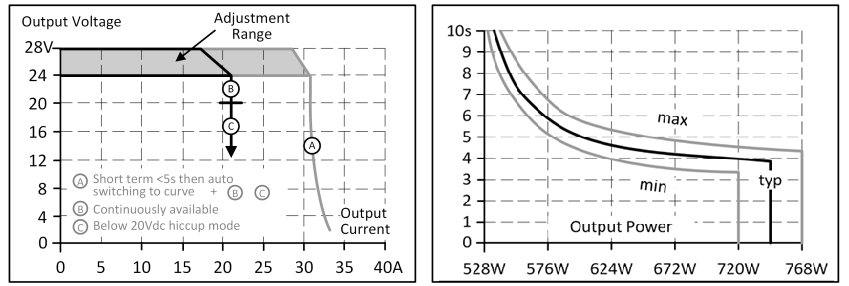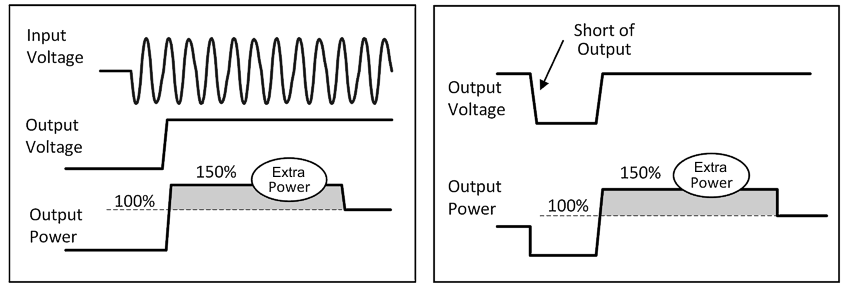Output
Output | |||
|---|---|---|---|
Output voltage | Nom. | 24 V |
|
Adjustment range | Min. | 24 - 28 V | Guaranteed value |
Max. | 30.0 V | This is the maximum output voltage that can occur in the end position of the potentiometer in clockwise direction due to tolerances. It is not a guaranteed value that can be achieved. A typical value is 28.5 V. | |
Factory settings | typically | 24.1 V | ±0.2%, at full load (cold device) |
Line regulation | Max. | 10 mV | Between 60 and 300 Vac |
Load regulation | Max. | 100 mV | Between 0 and 20 A, static value |
Residual ripple and ripple voltage | Max. | 100 mVPP | Bandwidth 20 Hz to 20 MHz, 50 Ohm |
Output current - | Nom. | 20 A | At 24 V, see Fig. Output voltage over output current |
Nom. | 17 A | At 28 V, see Fig. Output voltage over output current | |
Output current - | Nom. | 30 A | At 24 V, see Fig. Output voltage over output current |
Nom. | 26 A | At 28 V, see Fig. Output voltage over output current | |
Output power - | Nom. | 480 W |
|
Output power - | Nom. | 720 W |
|
Extra power time | typically | 4 s | Time until the output voltage drops, see Fig. Bonus time over output power |
Min. | 3.5 s |
| |
Max. | 4.5 s |
| |
Recovery time | typically | 7 s | Overload-free time until the power manager is reset, see Fig. Short circuit over output, Hiccup mode, typ.; Extra power recovery time |
Overload characteristics |
| Continuous current | Output voltage > 20 Vdc, see Fig. Output voltage over output current |
| Hiccup mode2) | Output voltage < 20 Vdc, see Fig. Output voltage over output current | |
Short circuit current | Min. | 30 A3) | Load impedance 50 mOhm, see Fig. Short circuit at output, Hiccup mode, typ.; extra power recovery time |
Max. | 40 A3) | Load impedance 50 mOhm, see Fig. Short circuit at output, Hiccup mode, typ.; extra power recovery time | |
Max. | 14 A3) | RMS value of current, load impedance < 10 mOhm, see Fig. Short circuit at output, Hiccup mode, typ.; extra power recovery time | |
Output capacity | typically | 8500 μF | Included in the power supply |
1) Extra power
The power supply is designed to support loads with higher short-term power requirements without damage or shutdown.
The short-time duration/bonus time is controlled in hardware by an output power manager.
Extra power is available repeatedly. Detailed information can be found in the chapter on Repeated pulse load.
If the power supply is subjected to extra power for longer than shown in the bonus time diagram (see Fig. Bonus time over output power), the maximum output power is automatically reduced to 480 W.
If the power demand is continuously above 480 W and the voltage drops below approx. 20 V (due to the current control mode in case of overload), the device switches off and periodically makes restart attempts. This behavior is referred to as hiccup mode (see description below).
If the voltage is above 20 V, the device supplies current continuously.
2) Hiccup mode
In the event of heavy overload (when the output voltage drops below 20 V), the power supply provides continuous output current for 2 s. The output is then switched off for about 17 seconds before a new switch-on attempt is automatically made. This cycle is repeated as long as the overload persists. After the overload has been rectified, the device will operate normally. See Fig. Short-circuit at output, Hiccup mode, typ.; extra power recovery time
During the pause time, a small open-circuit voltage and a small quiescent current are applied to the output.
3) The discharge current of the output capacitors is not included.
Peak current capability (up to several milliseconds)
The power supply can deliver a peak current that is higher than the specified short-term current. This helps to start current-intensive loads or safely operate downstream circuit breakers.
The additional current is supplied by the built-in output capacitors of the power supply. During this process the capacitors are discharged and cause a voltage drop at the output. Further information can be found in the chapter on Peak current capability.
Voltage drops at peak currents | |
|---|---|
Typ. 24 V to 20 V | At 40 A for 50 ms, ohmic load |
Typ. 24 V to 17 V | At 100 A for 2 ms, ohmic load |
Typ. 24 V to 16 V | At 100 A for 5 ms, ohmic load |


Extra power is available as soon as the power is turned on and after an output short-circuit or output overload.
